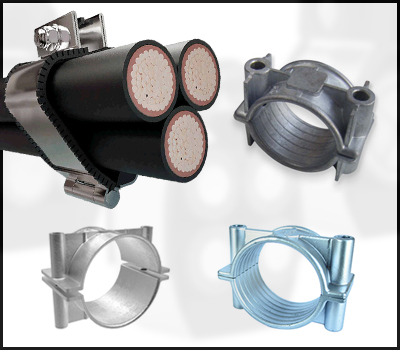The issue of Galvanic Corrosion was discovered in the onset of the eighteenth century. The first ever experiment of these types of corrosion was done on a frog with connecting a bimetallic conductor that contracted the nerves and muscles of a frog. Well! There are different kind of corrosion that comes in way at the time of Cable cleat installation. Among all, the Galvanic Corrosion is the one that has an adverse effect on the cable cleats to degrade its durability and reliability. In the current world of electronics, the cable cleat installation needs to be done that well support the resistance to galvanic corrosion. With this, the below article is a detail on how the cable cleat installation overcomes the issue of the galvanic corrosion?
What is galvanic corrosion? How does it work? What are the sources and the reaction of the Galvanic Corrosion? These are the common queries that are well depicted in this article in addition to the solution to avoid the adverse effect of Galvanic Corrosion during the cable cleat installation.
A Galvanic Corrosion is a kind of electrochemical operation in which a metal corrodes with another one through an electrical contact with the electrolyte existing as a strong driver to process of corrosion. When there is a presence of corrosive vapor or a water or moisture as an electrolyte and the corrosion between two unlike metals, the process of electrochemical operation that takes place is known as a Galvanic Corrosion. This kind of corrosion is also known as Bimetallic Corrosion Or Wrongly Electrolysis Or also termed as a Dissimilar Metal Corrosion.
Different electrode potentials exist in different alloy and metal. In an electrolyte, when any two unrelated metal or an alloy comes in electrical contact with one another, one of the metal reacts as a cathode and another as an anode. As the electrode potential varies with the reaction in two electrodes, it results in a rigorous attack on an anode metal.
The Galvanic Corrosion usually occurs in areas where there is rising degree of contamination due to halogen salts. This is majorly found in regions where there is regular rainfall or environment nearby to or on a sea cost that is prone to humidity. The Oil or Gas fueling operation or a power station or where the major conurbation exists are the areas where these kind of adverse effect of Galvanic Corrosion exists.
As the stainless steel becomes a prey for halogen salts, it molds the material to become more of a ‘passive state’ with disturbing the protective chrome oxide film. Any kind of galvanized or zinc coated structure is inimical when there is electrolyte present during the electrochemical reaction that gives room to dissolve the zinc and pace up the corrosion process as faster as it can. Keeping these demerits as a chief concern Stainless Steel Cable Cleats is durable and resistant to the adverse effects of Galvanic Corrosion.
Lets understand the if’s and but’s about how the cable cleats overcome the fallout of Galvanic Corrosion!
The wide range of cable cleats like Single Way Cable Cleat, LSOH Two Bolt Cleat, Two Bolt And Trefoil Typr Allumium Cable Cleat offers viable options to suit any magnitude of Galvanic Corrosion. This fortune is experienced at the time of installation as the majority of the cable cleats are lack of electrolyte in the external bodies or the environment which avoids to entertain a complex and harmful process of Bimetallic Corrosion.
Going into the roots of how the cable cleats shows its resistance to dissimilar metal corrosion! The chrome oxide film layer is inbuilt in the stainless steel that safeguards it from the environment that also state’s itself as an ‘active state’. With the existence of halogen salts, these kind of layer can be eroded in the form of chlorine, bromine, fluorine, astatine or iodine that have their presence in gas vapor or contaminated water. The stainless steel cable cleats are installed in a commercial or dry industrial environment in the absence of the electrolyte that makes it to be deemed in an ‘active state’, the Galvanic Corrosion does not take place between the cleat in addition to the structure that supported by the surrounding galvanized steel.
The recent research has accounted a use of effective cleat separation washer that helps overcome the issue of Galvanic Corrosion. This creates an insulated layer in the unlike metals, making a distance between the metals and discards the critical point of physical and electrical contact that develops corrosion. This type of cleat separation washer is recommended by the researchers to be used at the time of the external installation assignment.
The BICC Components Limited (BICC) is an expert manufacturer and distributor of the varied type of Cable Cleats that have their applicability in all the simple and complex cable gland installations. Having a diverse customer base from Oil & Gas, Mines & Quarries, Marin, Power distribution & transmission, Water work & Waste water management, Chemical and many more sectors in the global market, our tooling room and R&D have parallel operations to bring out continuous improvement and innovations in the current market trends. cable cleats are equipped with material inputs that completely support and resist the adversities of Galvanic Corrosion. Stopover https://www.bicccomponents.uk.com/cable-cleats/ to know more about the wide range of cable cleats. Also, feel free to give us a call or drop a mail to us in case of any kind of queries or to get a quote. Visit https://www.bicccomponents.uk.com/contact/ to get contact details.
 SUBSCRIBE TO OUR BLOG
SUBSCRIBE TO OUR BLOG
